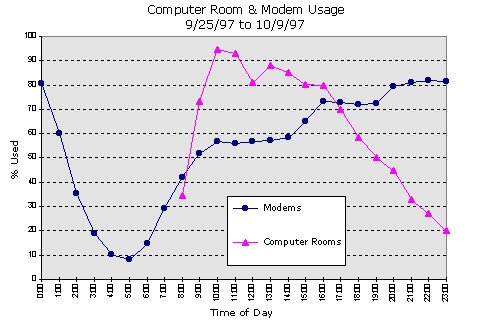
Volume 6, No 2
 Information Technology News of the University of California, Davis
Information Technology News of the University of California, Davis  October 1997
October 1997

 Information Technology News of the University of California, Davis
Information Technology News of the University of California, Davis  October 1997
October 1997
 |
Maximizing Network AccessPreliminary Usage PatternsThe beginning of Fall Quarter saw the arrival of record numbers of enrolled students on our campus -- 24,450 to be precise. These large numbers are likely to generate more traffic, both in the campus computer rooms and on the UC Davis modem pool. The data available for the first ten weekdays of the quarter (9/25 through 10/9/97) and depicted in the graph accompanying this article provide a basis for helping you find the best times to utilize the campus modems and computer rooms. Modem PoolThe UC Davis modem pool is split into SLIP/PPP modems and regular modems. Commonly used for browsing the Web and for performing large data file transfers, SLIP/PPP connections are accessed by dialing 752-7925. With 70% of the total number of modems available, this pool is the busiest: it receives the most calls daily (approximately 79%) and the average call lasts longer (approximately 45 minutes). Busy signals are typically associated with dial-ins to this pool. The other pool, available by dialing 752-7900, provides a more general level of service. It is typically used for accessing e-mail and newsgroups. Consequently, the average call is much shorter and lasts only about 18 minutes. This pool may prove easier to access if you do not need to browse the Web. The graph shows that the majority of calls to the modem pool during the first ten weekdays of the quarter occurred between 3 p.m. and 1 a.m. Between 9 a.m. and 4 p.m., 50% to 70% of the modems were in service. Clearly, the quietest period was from 2 a.m. to 8 a.m., when the modem pool was utilized at less than half its capacity. On the busiest 24-hour time period, approximately 25,000 calls were made. Yet the modem pool did not reach full capacity, peaking at slightly over 80% of capacity between 8 p.m. and 12 a.m., when more than 400 dial-in users were logged on simultaneously. The volume of calls is expected to rise throughout the quarter as e-mail and Web usage are incorporated into classes. The general trend should remain similar to what the graph depicts: more calls in the evening and late night time frame, and fewer calls in the early morning and regular daytime hours. Regular modem usage statistics and network status information are available on the Web at http://netstat.ucdavis.edu/ 
Computer RoomsWhen the campus computer rooms are not used for class, they are available on a drop-in basis and fill up quickly in the daytime. As depicted on the graph, the best time to find a computer for drop-in use is in the evening. The number of available computers increases sharply after 5 p.m. when fewer labs are reserved for class use. The computer rooms are used at less than half their capacity from 7 p.m. until they close. On the other hand, mornings are very busy with less than 10% of the computers available between 10 and 11 a.m. If your schedule does not allow you to remain on campus during the evening, you might be able to find an open computer during the day if you plan ahead. One of the best options is to check out the new open access lab in TB 114 where no classes are taught. If there are no open computers at the computer room you wish to use, the Site Attendant can direct you to one where machines are available. Or you can check the Web page developed by the Lab Management team to increase your chances of finding a computer when you need one. The Web page features frequent updates on seat availability and identifies which rooms are available for drop-in use each hour. You can access this information at http://lm.ucdavis.edu/rooms/available/. Report submitted by Matthew Matuszak (Communications Resources) with contributions by Dave K. Wong (Communications Resources) and Tim Leamy (Lab Management). |